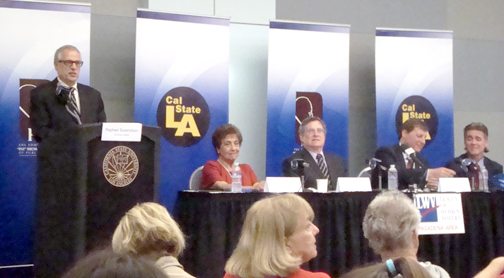
A forum on the proposed 710 extension presented both the pros and cons of the project by representatives from affected cities.
By Jason KUROSU
Three months remain in the SR-710 EIR public comment period, during which members of the public, affected cities, transportation agencies and others can weigh in on the best solution for connecting the 710 and 210 freeways. However, of the five remaining alternatives, the freeway tunnel proposal stands out as a major topic of debate.
A Monday night forum held at California State University, Los Angeles highlighted the divide between those advocating and those opposing a 6.3-mile long freeway tunnel. Four panelists representing four cities in the region agreed on the existence of traffic issues, but differed on viable solutions.
Barbara Messina of the Alhambra City Council supports the tunnel as a means for reducing surface street congestion, which she says renders streets into “parking lots.” Messina believes that the lack of a connection has contributed to her city’s traffic issues, as well as air pollution, particularly affecting local schools.
“The tunnel is the only alternative that addresses what the EIR is looking for. They specified that they need mobility, air quality and [less] congestion and the tunnel is the only alternative that meets those needs,” said Messina, who called the lack of a connection a “missing link in our freeway system that does not allow our system to operate at its maximum efficiency.”
John Fasana of the Duarte City Council also said the tunnel would be the best alternative, in combination with Transportation System Management/Transportation Demand Management (TSM/TDM) strategies.
Fasana said this would “offer the best alternative to move more people effectively on our freeway network.”
“Given the unique framework of where the gap is in the freeway, I think the tunnel is the option we really ought to look at seriously if we want to get the most economic vitality into this region,” Fasana said.
Ara Najarian of the Glendale City Council continued his opposition to the tunnel proposal, saying the freeway tunnel is costly and unsafe. Najarian supported a combination of three of the other alternatives: light rail, TSM/TDM and bus/rapid transit.
“I think a tunnel will cause more problems than we already have,” said Najarian. “Engineers will tell you they can build a stairway to Heaven, but we really need a more feasible, sustainable approach to our transportation.”
Michael Cacciotti of the South Pasadena City Council also opposed the freeway tunnel, in favor of expanded light rail.
“What’s best for the two million people of the San Gabriel Valley? To give them mobility or transit options in addition to just the car. And that is a light rail, mass transit system.”
The panelists debated whether or not the tunnel would become a major travel route for trucks moving cargo from the ports of Los Angeles and Long Beach.
Fasana said he believed that trucks did not need to be in the tunnel and would instead use alternate routes, using either the I-5 freeway heading north or heading east.
Najarian argued that the tunnel route is a “goods movement corridor” and said that tunnel proponents need trucks to be on the tunnel in order to make it work economically, using money received through tolls to pay for the total costs of the tunnel.
“The only way this makes any sense is to open it up to the trucks, because trucks, truckers and trucking companies are the only ones who will be willing to pay the toll on this tunnel,” said Najarian. “We’re talking about bringing a return to the private companies investing in this and the very last number I saw was a toll of $14 each way.”
Messina, who is vice chair of the Southern California Association of Governments (SCAG) Transportation Committee said that SCAG is working on a special truck corridor which would take trucks east on the I-60 and that trucks would not be using the 710 freeway, calling Najarian’s information “totally incorrect.”
The safety of such a tunnel was another topic of debate, both from an accident perspective to a tunnel’s effects on air quality.
Najarian said he “would instruct my family never to enter a five mile tunnel that has no exits. If something happens, you’re stuck in there.”
Messina said that tunnels have been in existence throughout history without such regard to their dangers.
“To say a tunnel is dangerous is really very, very lame,” said Messina.
The panelists differed on opinions of the effects on the region’s air quality, with tunnel supporters saying the tunnel would remove pollution from residential areas and opponents saying the tunnel would increase overall traffic, adding to the already problematic air quality. The EIR indicates that the tunnel would be built with air scrubbers and would feature 50-foot tall ventilation towers outside the tunnel entrances.
Messina said that school children in her area suffer from upper respiratory problems “because of the cars just idling there” on streets near Alhambra schools.
“That is just totally unacceptable and it’s gotten worse over the years,” Messina said. “We’ve got to get these cars off of our city streets.”
Cacciotti rebutted, saying “the tunnel will do nothing to get those cars off city streets,” arguing that population density contributed more to Alhambra’s traffic than not having a freeway connection.
“There’s no way adding 60,000 cars with the emissions of nitric oxide, carbon monoxide and particulate matter can improve air quality,” said Cacciotti.
Fasana argued that “the petroleum fuel vehicle is going the way of the dinosaur” and that a general widespread move towards cleaner, green vehicles is being ignored by tunnel opponents.
The public comment period continues until July 6. Two public meetings are scheduled for April 11 at East Los Angeles College and April 14 at the Pasadena Convention Center Ballroom. A third public meeting is still to be scheduled.
